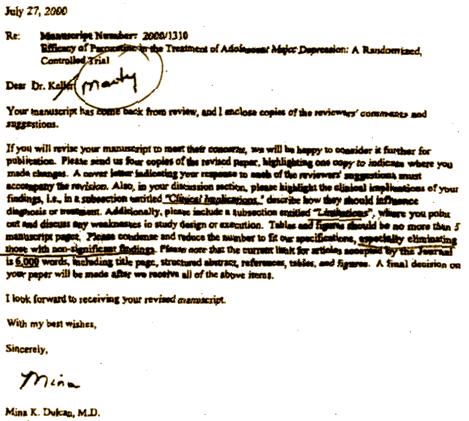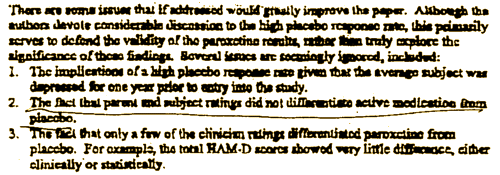Flash forward:
|
Breakthroughs in the Treatment of Child and Adolescent Depression & Anxiety
 Children grow out of shoes and clothes, but the odds say it is unlikely they will outgrow depression. A depressed child is twice as likely to be a depressed adult, according to Dr. Karen Wagner, a leading child psychiatrist. Dr. Wagner spoke to Neuroscience consultants at the launch meeting in Los Angeles. Dr. Wagner is Director of the Division of Child and Adolescent Psychiatry and the Vice Chair of the Department of Psychiatry and Behavioral Sciences at the University of Texas Medical Branch. Her message about major depression was that "it is a lethal disorder and it requires treatment." Children grow out of shoes and clothes, but the odds say it is unlikely they will outgrow depression. A depressed child is twice as likely to be a depressed adult, according to Dr. Karen Wagner, a leading child psychiatrist. Dr. Wagner spoke to Neuroscience consultants at the launch meeting in Los Angeles. Dr. Wagner is Director of the Division of Child and Adolescent Psychiatry and the Vice Chair of the Department of Psychiatry and Behavioral Sciences at the University of Texas Medical Branch. Her message about major depression was that "it is a lethal disorder and it requires treatment."Threat of suicide
Dr. Wagner pointed out that depression in adolescents can lead to suicide for 2.5% of those diagnosed with depression. Left untreated, the percentage rises to 8% as they become adults. Obviously, therapy is needed and Paxil is one of the few pharmaceutical approaches that has safety and efficacy data to support its use in this patient population. And more data is on its way. As many of you know, SB is preparing an indication for adolescent depression for Paxil next year! SB’s clinical study demonstrating the success of Paxil in treating depression among adolescents will be published in a peer reviewed journal during first quarter 2000… |
It’s hard to recapture the ethos of recent history. It’s still too nearby for editorializing. This is as close as I can get. It was extracted from a SmithKline Beecham newsletter, Nulli Secundus [second to none] dated December 8, 1999. Dr. Wagner is showing a slide of all the drugs that were in clinical trials for pediatric depression and is proudly announcing that Paxil’s success would be published in a peer reviewed journal, and would soon to be submitted for FDA approval for adolescents [we now know from subpoenaed documents that a year earlier, SKB had decided that Study 329 was too weak to submit for approval, but let’s not be picky]. Notice the emphasis on peer reviewed journal. Peer review is the stamp of approval throughout academia. It means that an article has been closely-read by other scholars in the field and approved as a meaningful contribution to the literature. By this time, it had taken on an additional meaning in psychiatry, particularly with industry-funded studies. It meant that the article was no longer relegated to the free throw-away medical journals that fill our mailboxes on the way to the waste-can. It was essentially certified as a non-advertisement [or at least that’s what it was supposed to mean]. Publication in a peer reviewed journal and FDA Approval mean the drug can be directly advertised [and in a practical sense mean millions, perhaps billions, in revenue for the life of the patent]. So maybe they wouldn’t submit Paxil to the FDA for adolescents after all, but with a published article, it might be prescribed widely "off-label."
|
SB’s advantage
Dr. Wagner said the window of opportunity is before SB. Several other competing SSRIs and other compounds have studies ongoing. But Paxil and Prozac are the only two SSRIs that have any published data to date and many physicians have already found success in treating adolescent patients with Paxil… |
[Well. Maybe second to one…]
Flash back:
 The Study 329 article had fallen on the first hurdle out of the gate when the Journal of the American Medical Association turned it down, a submission in line with their longstanding plan of encouraging Primary Care Physicians to treat depression [with Paxil]. The reviewers pointed to the low HAM-D [12] cut-off, the effect of supportive care, the high Placebo response, the small or absent differences in rating scales, the significant incidence of Serious Side Effects with Paroxetine, and the inappropriate dosing of Imipramine. The rejection letter suggested submitting the article to the Archives of General Psychiatry. In a letter to Jim McCafferty of SKB, Sally Laden had other ideas [December 7, 1999]:
The Study 329 article had fallen on the first hurdle out of the gate when the Journal of the American Medical Association turned it down, a submission in line with their longstanding plan of encouraging Primary Care Physicians to treat depression [with Paxil]. The reviewers pointed to the low HAM-D [12] cut-off, the effect of supportive care, the high Placebo response, the small or absent differences in rating scales, the significant incidence of Serious Side Effects with Paroxetine, and the inappropriate dosing of Imipramine. The rejection letter suggested submitting the article to the Archives of General Psychiatry. In a letter to Jim McCafferty of SKB, Sally Laden had other ideas [December 7, 1999]:-
Sally Laden and Jim McCafferty will summarize the reviewers’ extensive comments and draft a memo outlining the changes to be made.
-
This memo will be circulated to all authors for their review and approval.
-
The current draft will be revised and circulated to all authors for review and approval.
-
The revised manuscript will be submitted to American Journal of Psychiatry.
- • Five copies of the manuscript (submit four to the journal; keep one for your files)
• One set of glossy prints of the figures (submit to the journal)
• A draft cover letter to Dr Dulcan, editor of.JAACAP (please retype on your letterhead and revise, as you like)
• A diskette containing your manuscript in Microsoft Word 97 format for your use in the, event revisions are needed
• Your disclosure information (submit to the journal).
On behalf of Sally Laden, it has been a pleasure working with you on this project, Please keep us apprised of the status of the paper. If revisions are required, we will be happy to assist you…


And in the version of the paper they received, the abstract said:

So the reviewers wanted to know where the a priori primary variables were, why they weren’t separated out. They wanted to know the rationale for not using the Bonferroni Correction for multiple outcomes. One reviewer commented, "The authors should not overstate the efficacy of paroxetine." After several rounds of exchanges with the reviewers [November 2000 and January 2001], the paper was accepted in February 2001.
The Editorial
The peer reviewers did their jobs, both at the JAMA [1][2] and the JAACAP [3][4][5]. I would’ve been happier if they had said something like "This is an industry-sponsored study that is deceitfully written and does not support its conclusion. It should not be published." But they pointed out the weaknesses and challenged the conclusions. They told the editorial boards enough to make sensible publications decisions.
I find the abrupt change of targeted journal from the American Journal of Psychiatry to the Journal of the American Academy of Child and Adolescent Psychiatry in the summer of 2000 suggestive that there’s some piece of the back story here that remains in the clouds. It came out of left field. Dr. Dulcan’s letter to Dr. Keller initiates the process of publication in spite of what seem to me to be terminal comments from the reviewers. And the friendly "Dear Dr. Keller Marty" salutation just fuels my suspicions. These things look much worse under the magnifying glass of all the information available from subpoenaed documents – the industry management of the study, the ghost writing, etc. But that’s the story we have to work with, and some kind of political dealings would explain the confusing document of June 2000. There’s no substantiating documents that I can locate, so I’m left with only a suspicious mind [in this case, I’m at least justified in that].
-
Table 2, the outcome parameters with no annotation of primary or secondary and the addition of the first parameter [HAM-D < 8] invented after the fact.
-
Table 3, the listing of Adverse Effects with no annotation of Serious Adverse Effects and with suicidality filed under "emotional lability."
-
A conclusion ["Paroxetine is generally well tolerated and effective for major depression in adolescents"] that is unsupported by the paper itself.
-
The list of outcome parameters that lack the Bonferroni Correction mandated by the number of outcomes reported, a correction that would leave them with only 1/8 outcomes reaching significance.
… and the deceit goes on. For instance, change from baseline HAM-D score was stated as a primary outcome variable but no analyses of this key measure are given in Table 2 of the published article. On the other hand, there is a Figure showing these data by group, but without any analyses. The intent seems to have been to spin an impression of efficacy from this Figure even though, as I verified from the raw data that Mickey made available, there was no significant difference between Paxil and placebo. I have called this deceit the statistical equivalent of hand waving.